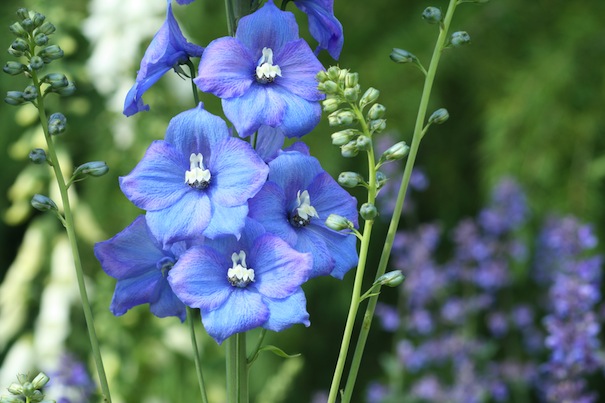As the days get shorter and cooler, Ann looks at how to get the most from your lawn, borders, baskets and veggie patch.
The heatwave that we had from July onwards will have scorched most lawns, but as we get some rain, they start to regrow and look better. There’s little point in watering a lawn in dry weather – it’s surprising how quickly it will rejuvenate once the weather turns cooler and damper. September and October are ideal months for aerating the lawn, after which you can apply a good lawn feed to nourish your lawn through the winter months. Reseed or returf any bare patches. Garden centres can deliver turf (we deliver fresh turf every Friday). Watch out for the larvae of the daddy long legs (crane fly), which can become apparent in lawns during August and September; they will attack most soils but in particular damp soils and heavy clays.
If we get a nice spell towards the end of August and into September, the chances are that a lot of the earlier flowering perennials will send up a new set of flower buds, so prolonging the flowering season. There are several new varieties of foxgloves, delphiniums and lupins out now and they make a cost-effective alternative to summer bedding.
A winter home for flowers
As the nights draw in and the weather gets cooler, the summer hanging baskets and pots begin to fade. Now’s the time to decide if you’re going to overwinter any of the plants by bringing them inside.
Geraniums and fuchsias can be trimmed back and potted up for the winter. Make sure that they are placed somewhere frost free – a spare bedroom, utility room, conservatory or garage that has some slight heat in the winter. In a severe winter, an unheated garage will not be suitable for the storage of cold sensitive plants.
Begonia corms and dahlia tubers can be dried off and again stored in a frost free environment – wrap in newspaper or dry peat and dust with sulphur powder before storing.
Autumn and winter colour
Why not replant your empty basket for the winter; there’s plenty to choose from – pansies, violas including the new trailing Teardrop variety, polyanthus, heathers, ivies and don’t forget to add a few spring flowering bulbs for added colour.
Once you’ve cleared the borders of summer bedding, you can replant with winter pansies, violas, sweet williams and wallflowers. Hopefully if the weather has been moist we’ll have some of our own field grown wallflowers available from the end of September – they give excellent value for money, flowering in the spring with the bulbs.
A bountiful harvest
Harvest onions and potatoes now – lift up onions and allow to dry out where they’ve been growing if the weather is fine, before storing. Potatoes should be stored in a cool but frost free environment. Hessian sacks that are available from garden centres are ideal for this purpose. Continue to pick runner beans and courgettes on a regular basis, so that they don’t become stringy. Pick any tomatoes before the first frosts and ripen on the windowsill or use for green chutney.
Pick early apples and pears as they become ripe. Eat the earlier varieties straight away, storing later ripening ones for later use. Cover autumn fruiting raspberries against birds. The old fruiting canes can be pruned out during the winter months as the autumn varieties fruit on new season’s growth each year.
Essential garden maintenance
Dead head roses, trimming back any very long growths. Remove any foliage with rust or blackspot, making sure you dispose of it rather than putting on the compost heap. Remember to clean up any debris under rose bushes as blackspot will overwinter ready to re-infect bushes next year.
Clean out greenhouses before putting in overwintering plants and insulate with bubble wrap. Check any heaters ready for the first frosts. As you bring in plants to overwinter, watch out for vine weevil larvae, especially on fuchsias. If you do see signs of them, drench the compost with one of the chemicals available for their control.
Buy prepared hyacinth bulbs for Christmas flowering and plant them in bowls with bulb compost by mid-September. Give them a drink and put in a cool, dark place, gradually bringing into the light and warmth once the shoots are around 3cm high.
When planting bulbs in containers for flowering next spring, it’s worth planting at least two layers of bulbs, slightly staggered one above the other. This will ensure a spectacular display. Plant the bulbs deeply enough to allow you to plant winter and spring bedding, such as winter pansies, primroses, violas, bellis, heathers and wallflowers on top.
We’ll soon be getting overwintering onions, shallots and broad beans in stock; plant them as soon as you can and you’ll get an early maturing crop next year.
This month’s tips are provided by Ann Winwood of Lealans Garden Centre, Shipley.







